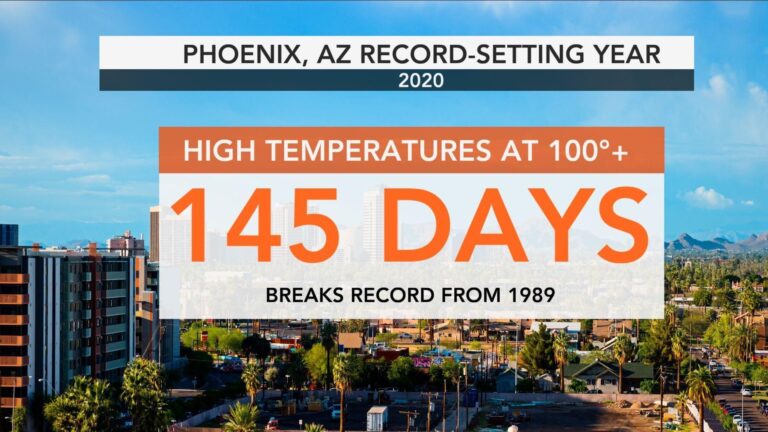Phoenix has reached a staggering milestone as temperatures soared to 100 degrees Fahrenheit for the 100th consecutive day, marking an unprecedented episode of relentless heat in the city’s history. This extended heatwave not only sets a new record but also raises critical concerns about the impacts of climate change, public health, and infrastructure resilience in one of the nation’s hottest urban centers. As residents cope with the unyielding swelter, city officials and experts are examining what this extreme weather pattern means for the future of life in the desert Southwest.
Phoenix Faces Record-Breaking Heat Wave Impacting Daily Life and Health
Temperatures soaring above the triple-digit mark for over three months have stretched the limits of Phoenix residents and infrastructure alike. Air conditioners in homes and public spaces are running nonstop, driving up electricity consumption and straining the power grid. City officials have issued numerous advisories urging citizens to stay hydrated and avoid outdoor activities during peak afternoon hours. Health services report a surge in heat-related illnesses, including heat exhaustion and heat stroke, highlighting the urgent need for community cooling centers and public awareness campaigns.
Main challenges faced by Phoenix during the ongoing heat wave include:
- Increased hospital admissions for dehydration and heatstroke
- Overburdened electric grid with rolling blackouts a persistent concern
- Widespread closure of outdoor recreational facilities and events
- Rising demand for emergency water distribution points in vulnerable neighborhoods
| Impact Area | Effect | Response |
|---|---|---|
| Health | Higher cases of heat-related illnesses | Opening of cooling centers, public health alerts |
| Infrastructure | Strain on power grid, risk of outages | Energy conservation campaigns, grid upgrades |
| Daily Life | Limited outdoor activities, event cancellations | Rescheduling events, providing shaded public spaces |
Energy Demand Surges as Residents Combat Prolonged High Temperatures
As temperatures in Phoenix soar above 100 degrees for the 100th consecutive day, residents are increasingly relying on air conditioning and cooling systems, leading to an unprecedented surge in energy demand. Utility companies report that the strain on the grid is nearing critical levels, prompting officials to urge conservation measures to avoid widespread outages. The unrelenting heat wave has compelled households and businesses alike to keep their cooling devices running longer and at higher settings, placing pressure on energy infrastructure and raising concerns over sustainability.
In response to the escalating energy consumption, authorities have emphasized the importance of adopting smart usage habits, including:
- Setting thermostats to 78°F during active hours.
- Utilizing energy-efficient cooling alternatives like ceiling fans.
- Closing blinds and curtains to block direct sunlight.
- Limiting the use of high-energy appliances during peak afternoon hours.
| Peak Energy Usage Hours | Recommended Conservation Action |
|---|---|
| 1 PM – 6 PM | Reduce non-essential appliance usage |
| 6 PM – 10 PM | Lower thermostat by 2-3 degrees gradually |
| 10 PM – 1 AM | Utilize natural ventilation when possible |
City Officials Urge Precautionary Measures to Prevent Heat-Related Illnesses
As temperatures in Phoenix soar to unprecedented heights, city officials are sounding the alarm on the dangers posed by prolonged exposure to extreme heat. Residents are urged to stay hydrated, avoid strenuous outdoor activities during peak hours, and seek out air-conditioned environments whenever possible. Public cooling centers have been established throughout the city to offer relief, particularly to vulnerable populations such as the elderly, young children, and those with medical conditions. The city’s health department emphasizes recognizing early symptoms of heat-related illnesses including dizziness, excessive sweating, and rapid heartbeat, stressing that immediate action can prevent severe outcomes.
To aid in heat safety, officials recommend adopting the following precautionary measures:
- Drink plenty of water even if you do not feel thirsty
- Wear lightweight, loose-fitting clothing and wide-brimmed hats
- Take frequent breaks in shaded or air-conditioned areas
- Avoid alcohol and caffeine, which can dehydrate the body
- Check on neighbors and family members who may be at risk
| Time of Day | Recommended Activity | Heat Risk Level |
|---|---|---|
| 6 AM – 10 AM | Outdoor Errands | Low |
| 10 AM – 4 PM | Stay Indoors or Use Cooling Centers | Very High |
| 4 PM – 7 PM | Light Outdoor Exercise | Moderate |
| 7 PM – Midnight | Relax in Ventilated Areas | Low |
Innovative Cooling Solutions and Community Support Highlighted Amid Crisis
As Phoenix endures its 100th consecutive day above 100 degrees, innovative cooling technologies have emerged as critical lifelines for residents. From solar-powered misting stations springing up in public plazas to the rapid deployment of community “cooling hubs,” city officials and private partners are collaborating to mitigate the extreme heat’s impact. These cooling hubs, often equipped with air-conditioned facilities, hydration stations, and shaded seating, offer refuge particularly for vulnerable populations such as the elderly and outdoor workers. This grassroots approach reflects a growing trend prioritizing sustainable, energy-efficient responses amid soaring temperatures.
Beyond technology, local nonprofits and volunteer organizations have mobilized extensively to provide essential services and raise awareness on heat safety. Key community initiatives include:
- Heat relief outreach: Door-to-door wellness checks in high-risk neighborhoods.
- Distribution drives: Handing out fans, water, and educational materials.
- Emergency response training: Preparing volunteers to identify heat exhaustion symptoms.
These coordinated efforts underscore how resilience is being nurtured not just through gadgets, but through community action and solidarity.
In Retrospect
As Phoenix endures its 100th consecutive day of temperatures reaching 100 degrees or higher, the city confronts the stark realities of prolonged heat in the American Southwest. This milestone underscores growing concerns about climate patterns, public health risks, and the demands placed on infrastructure and resources. Residents and officials alike continue to navigate the challenges of extreme heat, emphasizing the urgent need for adaptive strategies in an increasingly warming environment.







